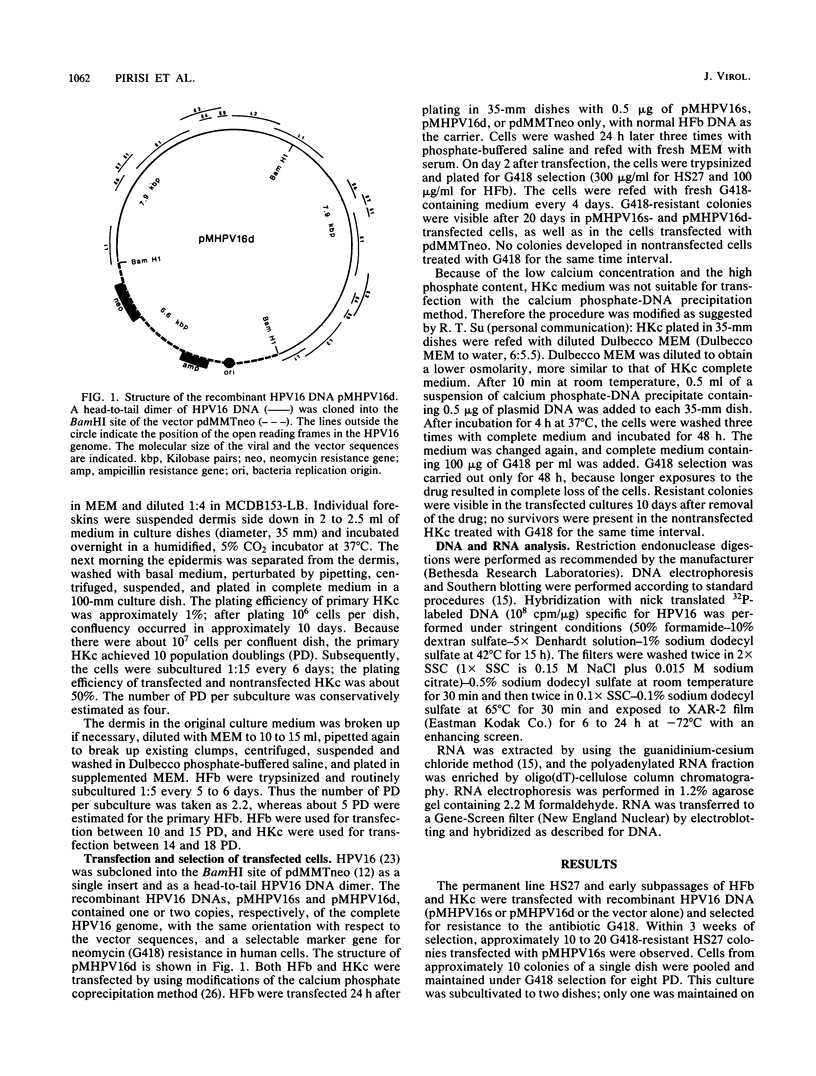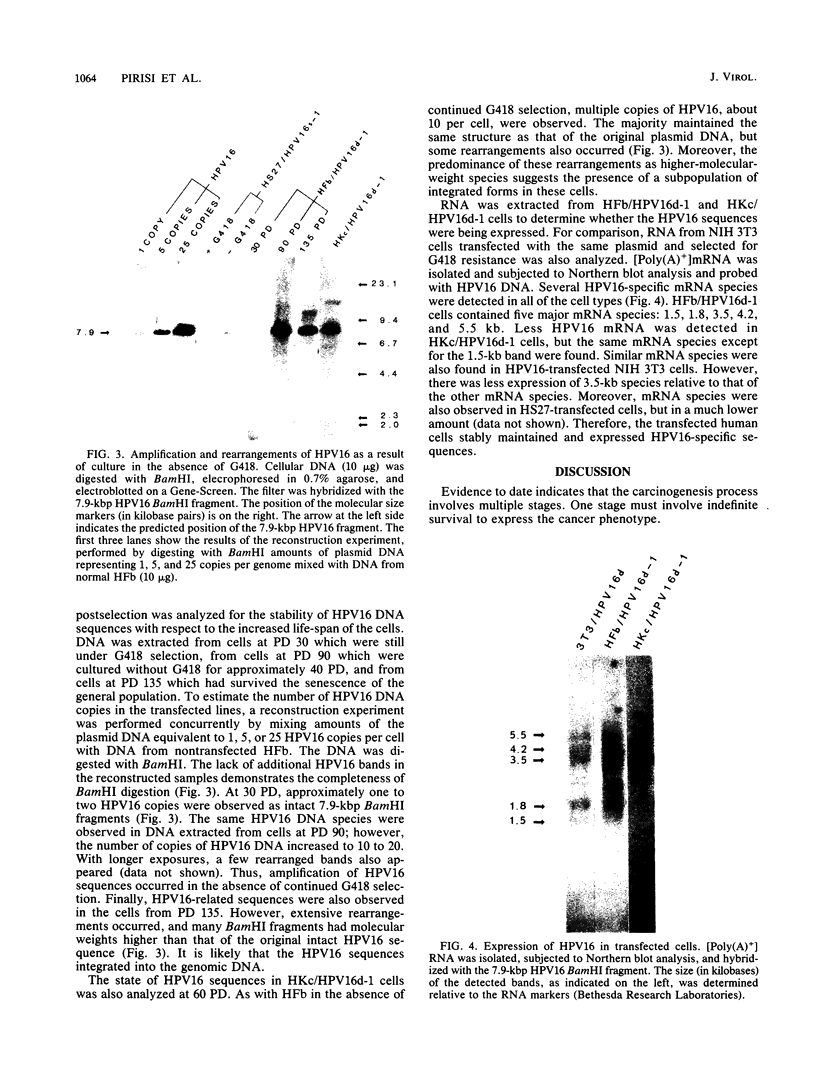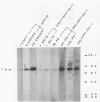Abstract
Human keratinocytes and fibroblasts isolated from foreskin were transformed by transfection with recombinant human papillomavirus type 16 (HPV16) DNA. The transformed cells exhibited an extended (fibroblasts) or indefinite (keratinocytes) life-span compared with that of normal controls. In addition, HS27, a human fibroblast cell line previously transfected with origin-defective simian virus 40, was successfully transfected. HPV16 sequences were stably maintained in the cells, and extensive amplification and rearrangements occurred with continuous culturing. Moreover, both fibroblasts and keratinocytes expressed several specific HPV16 mRNAs. Because HPV16-transfected cells had viral transcripts and because transfection with the vector alone did not extend the life-span of the cells, it is likely that the virus was responsible for the indefinite life-span. Transfected fibroblast and keratinocyte lines will be useful for investigating the molecular biology of HPV16 and the interactions between the viral DNA and the human genome. Moreover, transfected keratinocytes provide a model for analyzing the effects of HPV16 on the differentiation properties of human epithelial cells.
Full text
PDF





Images in this article
Selected References
These references are in PubMed. This may not be the complete list of references from this article.
- Burnett T. S., Gallimore P. H. Establishment of a human keratinocyte cell line carrying complete human papillomavirus type 1 genomes: lack of vegetative viral DNA synthesis upon keratinization. J Gen Virol. 1983 Jul;64(Pt 7):1509–1520. doi: 10.1099/0022-1317-64-7-1509. [DOI] [PubMed] [Google Scholar]
- Chesters P. M., McCance D. J. Human papillomavirus type 16 recombinant DNA is maintained as an autonomously replicating episome in monkey kidney cells. J Gen Virol. 1985 Mar;66(Pt 3):615–620. doi: 10.1099/0022-1317-66-3-615. [DOI] [PubMed] [Google Scholar]
- Crum C. P., Mitao M., Levine R. U., Silverstein S. Cervical papillomaviruses segregate within morphologically distinct precancerous lesions. J Virol. 1985 Jun;54(3):675–681. doi: 10.1128/jvi.54.3.675-681.1985. [DOI] [PMC free article] [PubMed] [Google Scholar]
- DiPaolo J. A. Relative difficulties in transforming human and animal cells in vitro. J Natl Cancer Inst. 1983 Jan;70(1):3–8. [PubMed] [Google Scholar]
- Dürst M., Gissmann L., Ikenberg H., zur Hausen H. A papillomavirus DNA from a cervical carcinoma and its prevalence in cancer biopsy samples from different geographic regions. Proc Natl Acad Sci U S A. 1983 Jun;80(12):3812–3815. doi: 10.1073/pnas.80.12.3812. [DOI] [PMC free article] [PubMed] [Google Scholar]
- Dürst M., Kleinheinz A., Hotz M., Gissmann L. The physical state of human papillomavirus type 16 DNA in benign and malignant genital tumours. J Gen Virol. 1985 Jul;66(Pt 7):1515–1522. doi: 10.1099/0022-1317-66-7-1515. [DOI] [PubMed] [Google Scholar]
- Franceschi S., Doll R., Gallwey J., La Vecchia C., Peto R., Spriggs A. I. Genital warts and cervical neoplasia: an epidemiological study. Br J Cancer. 1983 Nov;48(5):621–628. doi: 10.1038/bjc.1983.243. [DOI] [PMC free article] [PubMed] [Google Scholar]
- Kreider J. W., Howett M. K., Wolfe S. A., Bartlett G. L., Zaino R. J., Sedlacek T., Mortel R. Morphological transformation in vivo of human uterine cervix with papillomavirus from condylomata acuminata. Nature. 1985 Oct 17;317(6038):639–641. doi: 10.1038/317639a0. [DOI] [PubMed] [Google Scholar]
- LaPorta R. F., Taichman L. B. Human papilloma viral DNA replicates as a stable episome in cultured epidermal keratinocytes. Proc Natl Acad Sci U S A. 1982 Jun;79(11):3393–3397. doi: 10.1073/pnas.79.11.3393. [DOI] [PMC free article] [PubMed] [Google Scholar]
- Law M. F., Byrne J. C., Howley P. M. A stable bovine papillomavirus hybrid plasmid that expresses a dominant selective trait. Mol Cell Biol. 1983 Nov;3(11):2110–2115. doi: 10.1128/mcb.3.11.2110. [DOI] [PMC free article] [PubMed] [Google Scholar]
- Lehn H., Ernst T. M., Sauer G. Transcription of episomal papillomavirus DNA in human condylomata acuminata and Buschke-Löwenstein tumours. J Gen Virol. 1984 Nov;65(Pt 11):2003–2010. doi: 10.1099/0022-1317-65-11-2003. [DOI] [PubMed] [Google Scholar]
- Lehn H., Krieg P., Sauer G. Papillomavirus genomes in human cervical tumors: analysis of their transcriptional activity. Proc Natl Acad Sci U S A. 1985 Aug;82(16):5540–5544. doi: 10.1073/pnas.82.16.5540. [DOI] [PMC free article] [PubMed] [Google Scholar]
- McCance D. J. Human papillomaviruses and cancer. Biochim Biophys Acta. 1986;823(3):195–205. doi: 10.1016/0304-419x(86)90002-8. [DOI] [PubMed] [Google Scholar]
- Murnane J. P., Fuller L. F., Painter R. B. Establishment and characterization of a permanent pSV ori--transformed ataxia-telangiectasia cell line. Exp Cell Res. 1985 May;158(1):119–126. doi: 10.1016/0014-4827(85)90437-9. [DOI] [PubMed] [Google Scholar]
- Pfister H. Biology and biochemistry of papillomaviruses. Rev Physiol Biochem Pharmacol. 1984;99:111–181. doi: 10.1007/BFb0027716. [DOI] [PubMed] [Google Scholar]
- Popescu N. C., Amsbaugh S. C., Milo G., DiPaolo J. A. Chromosome alterations associated with in vitro exposure of human fibroblasts to chemical or physical carcinogens. Cancer Res. 1986 Sep;46(9):4720–4725. [PubMed] [Google Scholar]
- Schneider A., Kraus H., Schuhmann R., Gissmann L. Papillomavirus infection of the lower genital tract: detection of viral DNA in gynecological swabs. Int J Cancer. 1985 Apr 15;35(4):443–448. doi: 10.1002/ijc.2910350405. [DOI] [PubMed] [Google Scholar]
- Scholl S. M., Pillers E. M., Robinson R. E., Farrell P. J. Prevalence of human papillomavirus type 16 DNA in cervical carcinoma samples in East Anglia. Int J Cancer. 1985 Feb 15;35(2):215–218. doi: 10.1002/ijc.2910350212. [DOI] [PubMed] [Google Scholar]
- Schwarz E., Freese U. K., Gissmann L., Mayer W., Roggenbuck B., Stremlau A., zur Hausen H. Structure and transcription of human papillomavirus sequences in cervical carcinoma cells. Nature. 1985 Mar 7;314(6006):111–114. doi: 10.1038/314111a0. [DOI] [PubMed] [Google Scholar]
- Seedorf K., Krämmer G., Dürst M., Suhai S., Röwekamp W. G. Human papillomavirus type 16 DNA sequence. Virology. 1985 Aug;145(1):181–185. doi: 10.1016/0042-6822(85)90214-4. [DOI] [PubMed] [Google Scholar]
- Trevathan E., Layde P., Webster L. A., Adams J. B., Benigno B. B., Ory H. Cigarette smoking and dysplasia and carcinoma in situ of the uterine cervix. JAMA. 1983 Jul 22;250(4):499–502. [PubMed] [Google Scholar]
- Tsunokawa Y., Takebe N., Kasamatsu T., Terada M., Sugimura T. Transforming activity of human papillomavirus type 16 DNA sequence in a cervical cancer. Proc Natl Acad Sci U S A. 1986 Apr;83(7):2200–2203. doi: 10.1073/pnas.83.7.2200. [DOI] [PMC free article] [PubMed] [Google Scholar]
- Wigler M., Pellicer A., Silverstein S., Axel R., Urlaub G., Chasin L. DNA-mediated transfer of the adenine phosphoribosyltransferase locus into mammalian cells. Proc Natl Acad Sci U S A. 1979 Mar;76(3):1373–1376. doi: 10.1073/pnas.76.3.1373. [DOI] [PMC free article] [PubMed] [Google Scholar]
- Yasumoto S., Burkhardt A. L., Doniger J., DiPaolo J. A. Human papillomavirus type 16 DNA-induced malignant transformation of NIH 3T3 cells. J Virol. 1986 Feb;57(2):572–577. doi: 10.1128/jvi.57.2.572-577.1986. [DOI] [PMC free article] [PubMed] [Google Scholar]
- Yee C., Krishnan-Hewlett I., Baker C. C., Schlegel R., Howley P. M. Presence and expression of human papillomavirus sequences in human cervical carcinoma cell lines. Am J Pathol. 1985 Jun;119(3):361–366. [PMC free article] [PubMed] [Google Scholar]
- Yoshikawa H., Matsukura T., Yamamoto E., Kawana T., Mizuno M., Yoshiike K. Occurrence of human papillomavirus types 16 and 18 DNA in cervical carcinomas from Japan: age of patients and histological type of carcinomas. Jpn J Cancer Res. 1985 Aug;76(8):667–671. [PubMed] [Google Scholar]
- zur Hausen H. Human papillomaviruses and their possible role in squamous cell carcinomas. Curr Top Microbiol Immunol. 1977;78:1–30. doi: 10.1007/978-3-642-66800-5_1. [DOI] [PubMed] [Google Scholar]





